Real Irish Colcannon
Real Irish Colcannon is one of those classic Irish recipes that everyone loves. Made with green cabbage, Irish butter, and optional Irish cheddar cheese, it doesn’t get more Celtic than this. A traditional Irish dish with a history that may surprise you (hint: it’s not traditionally a St. Patrick’s Day dish).

I can’t think of anything more comforting than an easy side dish of traditional Irish mashed potatoes with heaps of Irish cheddar cheese and lots of butter. This is why I I call it ‘real Irish’. Based on a traditional Irish colcannon recipe, it’s a cross between Irish champ and colcannon with cheese and spring onions (green onions/chopped scallions).
Before you come at me, I know cheese and the onions are not traditional in colcannon; this is why they are listed as optional in the recipe and how my family made them back in the U.K.
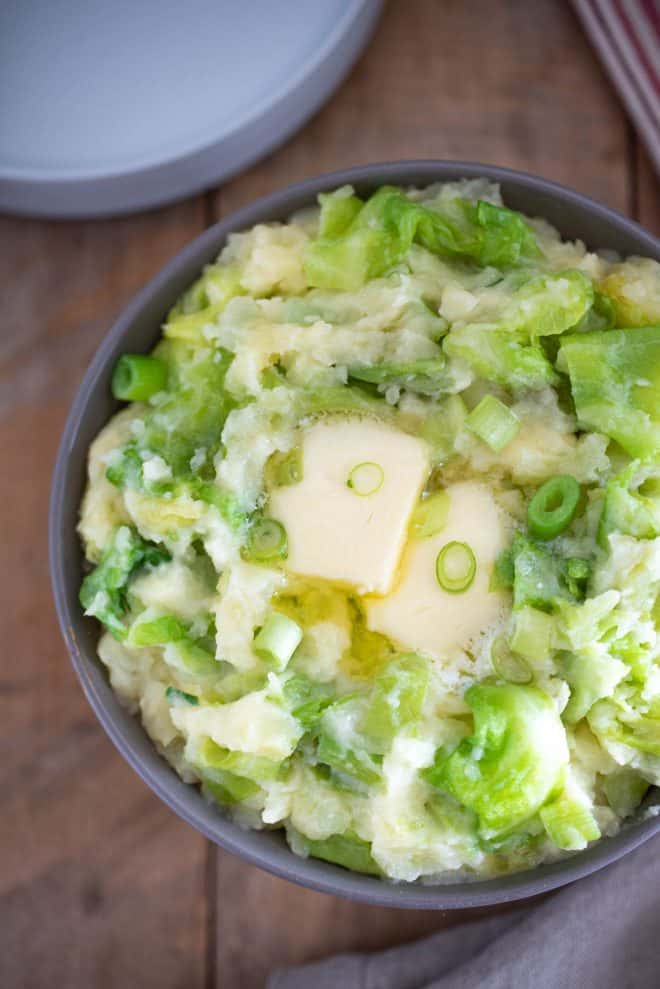
The butter and cheese are really the best there is out there. The Irish are very proud of their dairy and so they should be. I’m not being paid to say this, this is just my opinion and if you try them, you’ll agree and are available in most grocery stores here in the U.S.
Cabbage or Kale in colcannon
I receive many comments and messages, with some of you adding cabbage and others insisting that cabbage is NEVER used in colcannon, only kale. Read on for a little history of where cabbage plays a part in colcannon, as well as an ingredient that not many know about. Furthermore, it has nothing to do with St. Patrick’s Day but another holiday that will surprise you.
Colcannon history
The word colcannon comes from the Gaelic phrase ‘cal ceannann,’ which means ‘white-headed cabbage.’ On the 31st of October 1735 (yes, Halloween), Welsh politician William Bulkeley was on a trip to Dublin and wrote an entry in his diary (of which there are photos) that reads: ‘Dined at Coz. Wm. Parry, and also supped there upon a Shoulder of Mutton rosted (his spelling mistake, not mine), and what they call there Coel Callen, which is Cabbage boiled Potatoes & parsnips, all mixed together. They eat well enough, and it is a dish always had in this Kingdom on this night.'”

Using Irish butter and cheese
Because I see Irish butter and cheese in so many grocery stores, there was no reason not to use them in this recipe. The butter and cheese truly stand out as some of the best available. The Irish are very proud of their dairy, and rightfully so. I’m not being paid to say this; it’s just my opinion, and if you try them, you’ll agree.
Make ahead colcannon and reheating
A traditional colcannon recipe can be made 2 days ahead of time. You can simply reheat it in the microwave for a few minutes or in a pan over low heat. Add a small amount of milk to prevent it from drying out and burning on the bottom, stirring often.
Best potatoes for colcannon
I like Yukon Gold potatoes (similar to Vivaldi or King Edward in the U.K), which are floury potatoes that are creamy and have great flavor. Red potatoes, russets, Jersey Royals—all are good choices. Ultimately, the choice of potato is up to you; they will all work.
My tips for boiling potatoes
Start the potatoes in a large pot of cold water. The water comes up to temperature with the potatoes, ensuring they cook more evenly and faster. In lieu of a potato masher, I like to use a potato ricer for perfectly smooth mash.
Type of cabbage for colcannon
Traditionally, colcannon is made with either Savoy cabbage or green/white cabbage. The choice of cut is up to you:
- Large pieces: For a more prominent cabbage flavor and texture.
- Finely chopped cabbage: For a seamless blend with the mashed potatoes.
Brussels Sprouts in Colcannon
Feel free to substitute Brussels sprouts if you don’t have cabbage on hand. They’ll add a similar flavor and delightful texture to your colcannon so it mixes well with the mash. No cabbage? No problem, you can use any Brussels sprouts that you have.

What to serve with Irish colcannon
Traditional Irish food is a must—whether it’s the classic Irish stew (pictured above) or one of my personal favorites, Corned Beef and Potato Pie (picture below). They also make a delicious mash topping for Shepherd’s Pie.
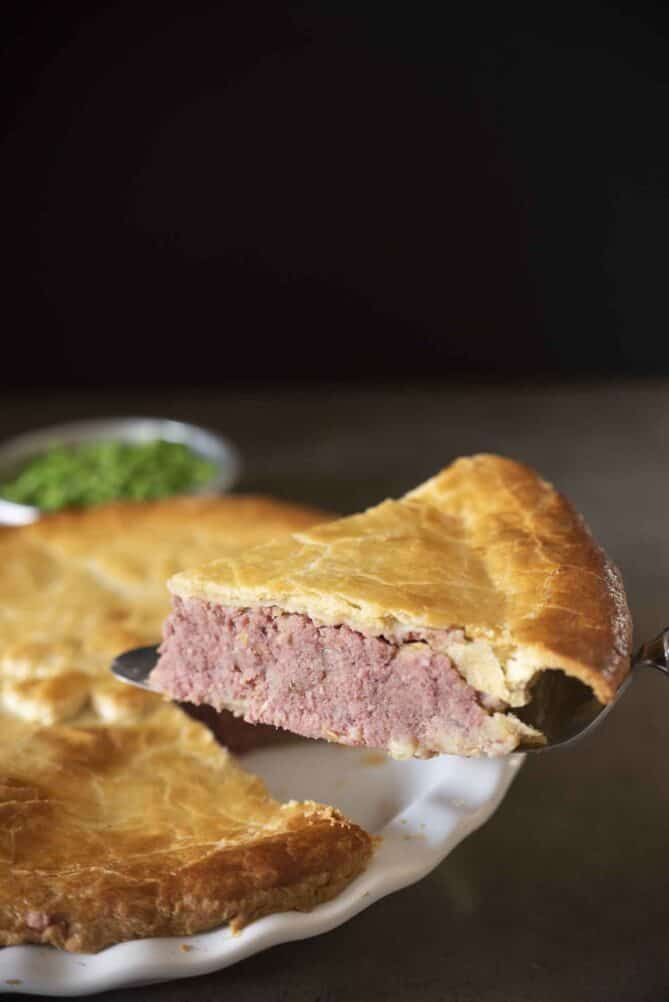
Leftover colcannon
If you happen to have any leftovers, don’t forget to store them refrigerated in an airtight container for up to 4 days. When you want to enjoy them, you can make a classic British dish called Bubble and Squeak (pictured below). It’s typically made from the leftovers of a Roast Beef Dinner, mainly the mash.
Reheating colcannon
The colcannon can be made 2 days ahead of time and reheated. You can simply reheat in a the microwave for a few minutes, or to a pan over low heat. Add a small amount of milk so it doesn’t dry out and burn on the bottom, stirring often.
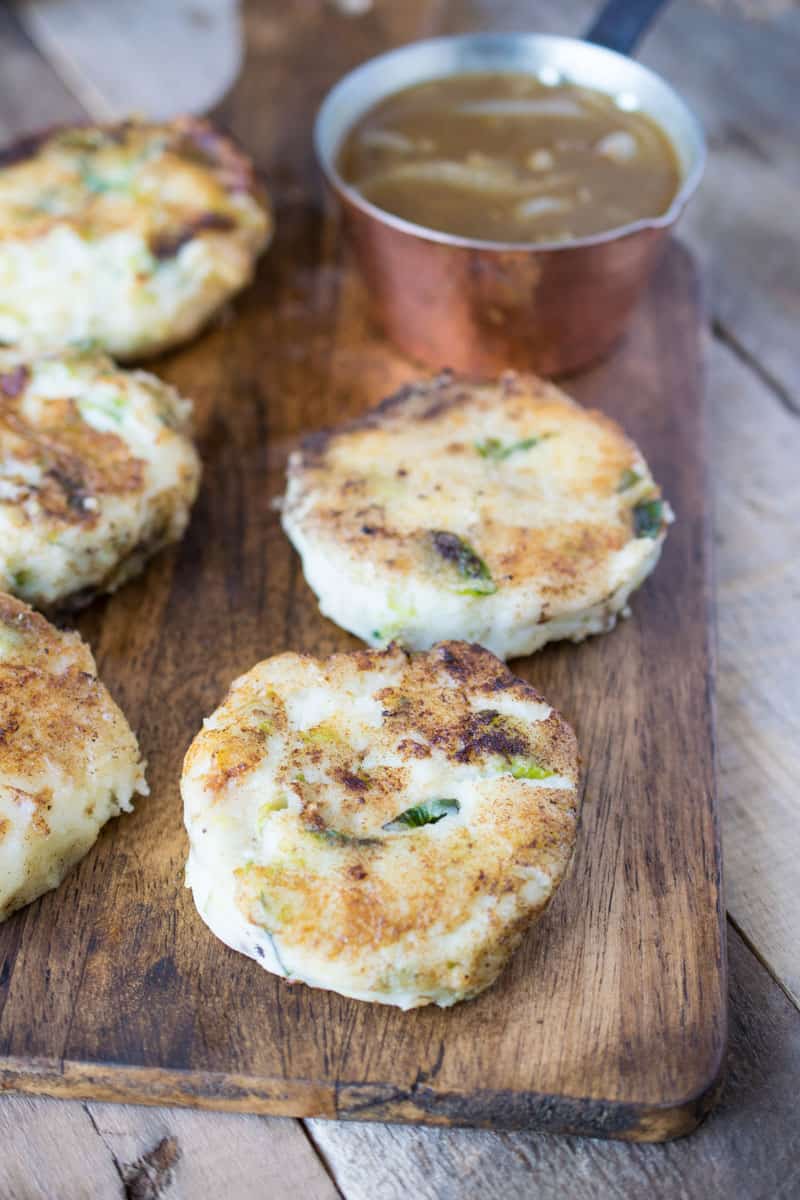
Irish Desserts
Why not try my Irish dessert ideas too if you want to complete Irish meal? Irish Chocolate Cake with Baileys Buttercream Frosting (picture below) or Irish coffee Milkshake Shooters.

If you’ve made this Real Irish Colcannon, or any other recipe, please leave a comment below. I love to hear from my readers.
Irish Colcannon
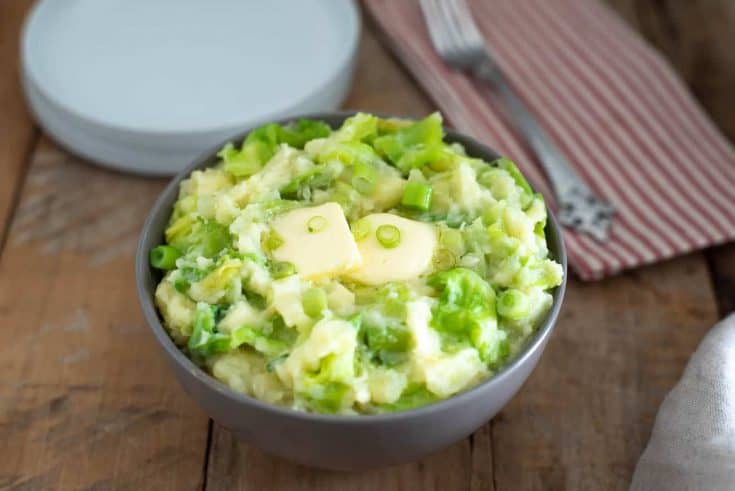
A creamy and easy side dish with cabbage, spring onion, Irish butter and Irish cheddar.
Ingredients
- 2 pounds (907 grams) potatoes, peeled and cut into large chunks
- 6 tablespoons Irish butter
- 2 spring onions/scallions, chopped (optional)
- 6 cups/10 ounces (284 grams) green cabbage or kale, chopped
- ¾ cup (180 ml) whole milk, warm
- 2 cups (160 grams) Irish sharp cheddar cheese, grated (optional)
- Salt to taste
Instructions
- Fill a large pan, ¾ way full with water and add the potatoes. Bring to a boil, then simmer for 20 minutes until tender.
- While the potatoes boil, melt the butter in a large skillet. Add the cabbage and cook until softened. Stir in the spring onions, remove from the heat.
- Drain the potatoes, add to a large bowl and mash. Stir in the cabbage and onion mix, milk and cheese into the hot potatoes. Season with salt to taste. Serve warm.
Nutrition Information
Yield
4Serving Size
1Amount Per Serving Calories 330Total Fat 23gSaturated Fat 14gTrans Fat 1gUnsaturated Fat 7gCholesterol 63mgSodium 429mgCarbohydrates 26gFiber 7gSugar 12gProtein 10g
This nutrition calculation is provided by Nutronix that is only a guideline and not intended for any particular diet.
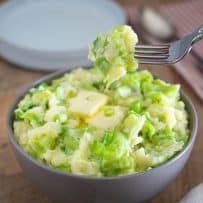
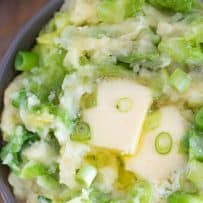
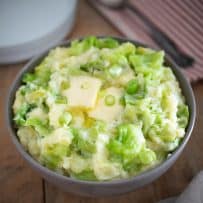

60 Comments on “Real Irish Colcannon”
Hi Janette,
Love all these ingredients so can’t wait to try this. I’m Ukrainian so cabbage is in my DNA (LOL) but I am so open to trying various recipes.
I hope you enjoy the recipe.
I made this colcannon for my St Paddy’s day dinner. It was fabulous the only change I made was to use fresh Kale along with cabbage, and I did not have green onions so I used a scallion. Turned out delicious and the cooking aromas were heavenly. It was a favorite for all who attended.
Thank you for sharing.
Thank you so much for sharing.
Hi, this may sound like a crazy question. Do you think brussel sprouts would work in lieu of cabbage? (I have those in my fridge currently). Otherwise I guess I’m going to the store 😉
Brussels sprouts would absolutely work as they’re a member of the cabbage family. I’d never have thought of this substitution, enjoy 😊
Just thought I would let you know that the shredded brussel sprouts were excellent!
Fantastic, thank you.
I am so going to try this tonight as a side. Brussel sprouts – not “traditional’ but will be oh-so good. Buttered carrots and good bread round out the corned beef simmering in the crock pot for dinner! Thanks for NEW inspiration.
Sounds like a tasty feast.
Thanks for this question! I have some brussels that need to be used 🙂
I just watched a documentary today about the potato and the linage goes back to the Peruvian culture. There have been many varieties from that era, and they have spread all over the world.
Wow, I had no idea. Thank you for sharing.
I can’t wait to make this for St. Patrick’s Day this year. I love the idea of adding Irish Cheddar. Could this be made ahead and reheated?
You can make it 2 days ahead. To reheat, you can do it simply in the microwave or in a pan over low heat. You can add a little milk if it is dry. Enjoy 😊
AsvI live alone I made a small recipe of this without the cheeze and milk .I used ted onion and boiled it all together and mashed it with butter,.excellnt..
Thank you for the feedback, I’m glad you enjoyed it
My husband said today “why don’t we have Irish colcannon tonight”. We are not Irish but I looked up a couple of recipes and we went out to get the cabbage, onions and potatoes. Well I have boiled the potatoes and have the other ingredients chopped on the board ready to cook.
I am not putting cheddar cheese in but maybe a handful of Parmesan. I haven’t got milk either as neither of us drink it but will add some potato water which I have in a jug ready.
I am making poached eggs with it on the side and maybe some fried mushrooms.
I’m sure it will be delicious and can’t wait to eat it.
This sounds like a delicious meal and the potato water is the perfect replacement for the milk. Enjoy.
I enjoyed this recipe. I will probably add some garlic to the cabbage next time, just because…
Thank you, that sounds delicious.
This is something I make a lot at our house. It is so yummy. My Irish heritage probably makes me little partial to these dishes too. But please try this instead of regular mashed one night.
Thank you for the feedback.
Any leftovers can go to bubble and squeak!! Same colcannon, two different dishes!!
Great idea
This was delicious! I had a half head of cabbage left over and only red potatoes. It was a great compliment to the ham I made. I looked at other recipes and saw a few variations but the addition of cheese was a great addition.
There are various recipes for this just as there are for chili!
Thank you for sharing!
Wonderful, thank you so much
I used a mix of cabbage and kale, fabulous
Sounds delicious
The best recipe, I love to use Yukon gold
Me too, thank you
This is actually a mix of Colcannon and Champ; two different dishes. Also neither dish would ever have cheese. This sounds delicious but it’s not real Colcannon.
Thank you, the cheese is listed as optional. My Granda taught me that colcannon is champ with added cabbage.
They’re similar, granted, but they’re separate dishes. Any cook can combine them as they please, but then they’re no longer actually their original selves. A family recipe is great but shouldn’t be sold as the ‘Real’ recipe, especially when including optional ingredients that entirely change the dish. Adding as we please, we end up with Loaded Mash, not Colcannon lol
I will not be changing the title of my recipe because the word ‘real’ bothers you. Again, I grew up in the U.K eating my granda’s recipe (that did not include onion or cheese) which is real colcannon. I like to help cater to my readers who are here to make my recipes, not people who just want to pick my recipes apart.
Love the recipe. From Tipperary and had it many times but had forgotten it. Will make it this weekend as giving company. Thank u.
You’re so welcome, thank you for the feedback.
I can’t believe I had never heard of colcannon before! I made it a few nights ago and it just blew my socks off! The leftovers also make the absolute best potatoes cakes. I skipped the egg since there was cheese binding it, added flour, rolled in them panko and cooked in the air fryer. So so so wonderful!
I’m so glad you loved the recipe and I must try the potato cakes next time.
I’ve been making mine like this but without the cheese for over 50 years. Sometimes I add bacon; (and use the bacon fat for cooking the cabbage) sometimes I add cubes of ham; usually I just make plain colcannon. Having my kids and grands for dinner Saturday and they love cheese, so will try it with cheese. Thank you.
I love the idea of the bacon and will give it a try. I hope the kids enjoy it with the cheese 🙂
I’ve never had colcannon with cheese in it before, I’ll have to give this a try!
Irish cheddar, just like my mum used to make. Enjoy 😁
Can I just say amazing. The cheese and butter really makes it taste so good
You can, and thank you 🙂
Great recipe. Brought back lots of memories. Try this as a topping for Cottage (Shepherds ) Pie. or with a side of mashed turnip and carrot.
Thank you for the feedback. I love the idea of a shepherd’s/cottage pie topping.
I had a huge head of cabbage for St. Paddy’s Day, so saved half. Made this yesterday, with a few changes. I fried bacon and used the grease to sauté the cabbage and some green onions, which I folded in to the mashed potatoes, along with the butter and cheese. Crumbled the bacon in as well. Sumptuous!
This sounds delicious, thank you for sharing your cooking tips.
So happy to find this recipe. I can honestly say that I really look forward to trying it and I hope I can find authentic ingredients to use. Just in time for St Patrick’s day menu planning.
Thank you so much Carol, this is one of my most popular recipes.
What is Irish cheese?
Hello Sam, Irish cheese is cheese made in Ireland.
Delicious!! Made this for Christmas dinner and ii’s a keeper!
Thank you so much for the great feedback Linda, glad you enjoyed it
Oh man, just made some to go with beef stew for lunches tomorrow, and boy is it delicious! So glad I have plenty leftover so I can just eat a few spoonfuls before saving the rest for later. Ive been missing out!
I’m glad you liked it, thank you for the feedback Ashley.
Hi, Jannette, What a great recipe, it looks like it will be a big hit with my family. Honestly, I have never heard of this dish before…I am not sure how I missed out on such deliciousness.
This looks delicious, Janette! This is definitely going on my St. Patrick’s Day recipe list! And I totally agree, KerryGold is gold! 🙂
This is the perfect way to celebrate St. Patrick’s Day! And the addition of KerryGold makes it even better! Yum! Thanks for sharing your recipe. I love this!